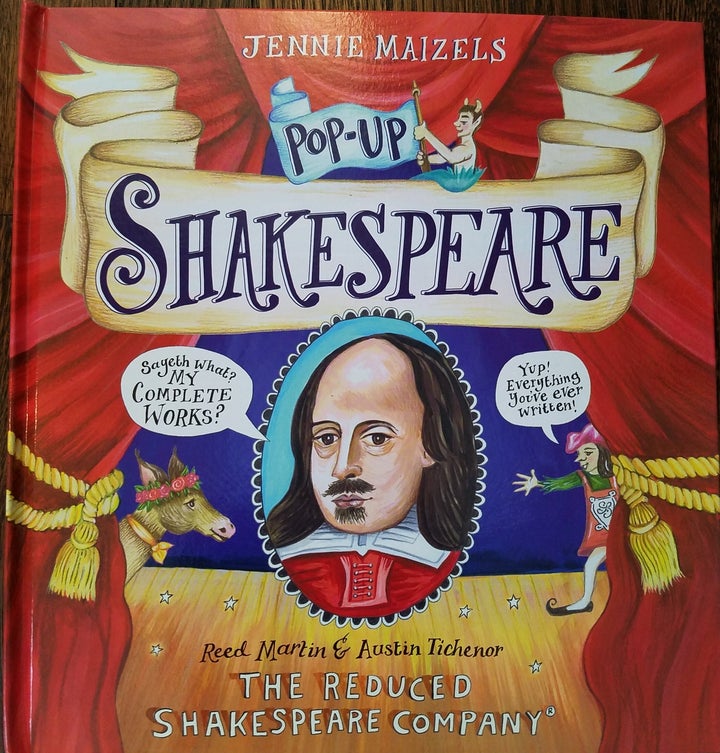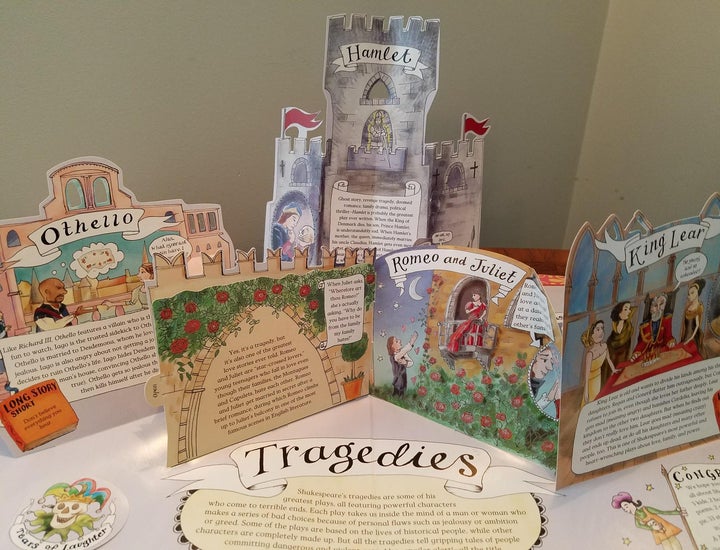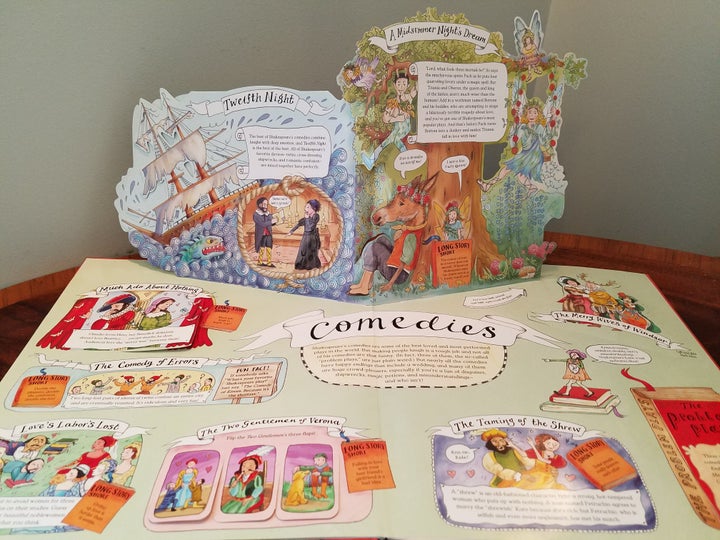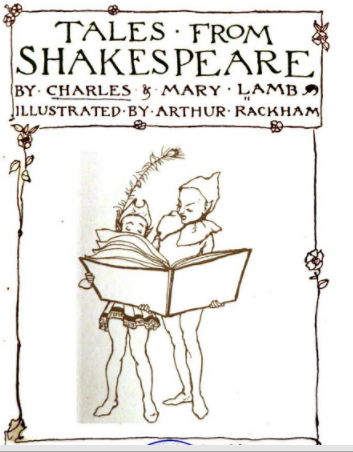
Pop-Up Shakespeare
I was in the children’s section of our local library when I came up with another topic that would have made for a good dissertation.
Shakespeare for children!!! I texted a girlfriend, without context. To clarify, I snapped a picture of a beautifully illustrated children’s edition of Shakespeare’s stories – one now on top of the heap of Thomas the Train’s and Pete the Cat’s chosen by my daughter.
My dissertation – on the very child-unfriendly topic of poison, revenge, and plague in Shakespeare and his contemporaries – was already completed, approved, and archived, but still, I let my mind wander into that trance state where so many book projects, novels, and ambitious schemes have congealed into the bulbous, puffy dream-clouds of my brain-scape.
? was my friend’s response, but I was convinced. Next book project, maybe? I could start with the Lamb siblings’ Tales from Shakespeare – that hilariously antiquated children’s version of the plays printed in 1807 – and move forward, maybe to some of the contemporary comic strips and kid-ified texts listed here.
“Not this!” my toddler said, as I tried showing her the cartoon Hamlet. As a newborn, she’d likewise rebuffed my efforts to introduce her to a Romeo and Juliet counting primer (1 balcony, 2 fair households…). She wasn’t exactly encountering the magic of Shakespeare as much as gnawing the primer all the way down to the cardboard. There’s a sense today that a goal – if not the goal – for children’s editions of Shakespeare is to make the stories more approachable and accessible. It’s what the writer of this NY Times Op-ed might call a “dumbing down” of the Bard. But approachability isn’t necessarily a question of simplification (nor is simplification inherently “dumbing down,” but that’s a point for another article). In fact, the more interactive the adaptation of Shakespeare – the more imaginative and fresh the new version – the more it compels our attention, young and old. Every adaptation reimagines its source and makes it again, new: and each creation is alive, and present, and urgent for its own time and place.
So you can imagine my happiness – and interest – a year later, when our family friend Austin Tichenor collaborated with Reduced Shakespeare comrade Reed Martin and artist Jennie Maizels to create Pop-Up Shakespeare. The pages are stunning – a set of interlocked castles in the “Tragedies” page; the doubled-sided ships and water ways (Twelfth Night and the Merchant) and forests (Midsummers and As You Like It) on the “Comedies” page; the Richards hiding behind the triumphant Henry V like their secret, shadow stories on the “Histories” page. Along with the three-dimensional illustrations are “reduced” glosses at their most pithy: the take-aways, trivia, and plot summaries that feel like mini-discoveries.

“A little book!” My daughter was hooked, instantly. She especially enjoyed the “baby books” of the Two Gentlemen of Verona – one of the three flaps for the play has a picture of the dog Crab, who she’s named “Broccoli.” The book necessarily combines narrative with the visual and tactile explorations of an artfully arranged spatial topography – my daughter flips pages, opens flags and mini-books, moves from forest to castle to garden, all while asking me to “read the story, please, Mama.”

When I first heard about the project, I wondered who the target audience was: kids, or adults. And, if children, would it target toddlers, or grade-schoolers? Was it too destructible for newborns? Now seeing the finished form, the answer seems to be that it’s for everyone: it’s funny and adult-enough for “grown ups,” narratively compelling enough for older kids, visually stimulating enough for toddlers, and not too delicate for very small children (although, be prepared with tape). But, the book’s broad appeal got me thinking once again (oy!) about our larger cultural interest in Shakespeare – why Shakespeare, still? – and, in this case, the particular interest in bringing Shakespeare to children – why Shakespeare for kids?.

Tales from Shakespeare. Taken from New York: J.M. Dent, 1909 edition.
In the past, Shakespeare was thought to teach children invaluable life lessons. The Bard was often a replacement deity for an era of growing agnosticism. Charles and Mary Lamb, the sibling duo mentioned above, speak in their preface about the instructional lessons their childish readers might take away from their Tales from Shakespeare. His “sweet and honorable thoughts” in addition to his “generosity” and “humanity” help strengthen a child’s “virtue.” But, interestingly, they spend more time addressing the crucial influence Shakespeare has not on the development of children generally, but on girls specifically. They acknowledge that girls are not “permitted the use of their fathers’ libraries” like boys. The Lambs’ new adaptation, then, offered girls the chance to read a version of Shakespeare that was simple enough for them to understand, but stimulating enough to make them want to read the originals (eventually). Charles and Mary urge brothers in the meantime to offer their “kind assistance[…] in explaining to their sisters such parts as are hardest for them to understand” so that:
“When they [the brothers] have helped them [the sisters] to get over the difficulties, then perhaps they will read to them (carefully selecting what is proper for a young sister’s ear) some passage which has pleased them in one of the stories … and it is hoped they will find that the beautiful extracts, the select abstracts […] will be much better relished and understood.”
Obviously, we don’t imagine today that our children’s versions of Shakespeare are helping young girls reach towards that unattainably high academic level of boys: the opposite gender disparity is more often noted in childhood learning. But the goal still seems to be that the childhood stories point the way to the originals – that introducing children to the tales of Shakespeare in a variety of narrative forms will lead them to the “beautiful extracts” of the plays themselves.
This is as true for Pop-Up Shakespeare as for the Romeo and Juliet primer. But Pop-Up Shakespeare reminds us of the other “side” of the adaptation-source dynamic, and not only because of its three-dimensional “sides.” We are reminded that each story is its own creation, and provides its own source of pleasure. Pop-Up Shakespeare, like so many of Jennie Maizels’ other pop up classics, brings Shakespeare to life in a way we don’t experience with the plays. Doubles and shadows come to life visually and spatially – humor and “reduction” present new ways of engaging with the plays. As is so often the case, the stories aren’t so much retellings as they are tellings. And who knows – maybe in this age of iPads and screens, the multi-dimensional Pop-Up will remind kids and adults to appreciate the presence and physicality of this unique take on Shakespeare.
